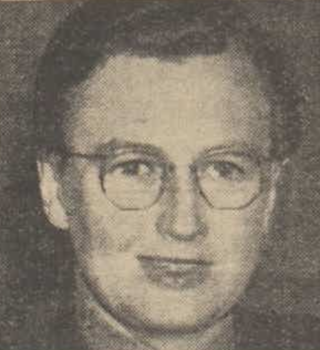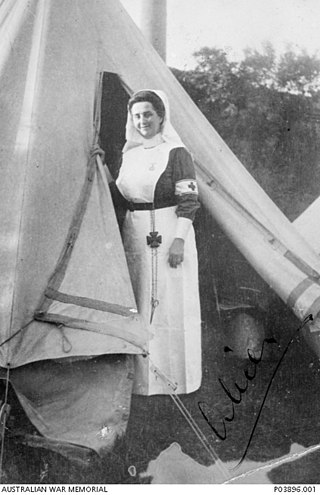
Louise Taplin (1855-1901) was an English-born Australian nurse, children's home matron and charity worker. [1]

Louise Taplin (1855-1901) was an English-born Australian nurse, children's home matron and charity worker. [1]
Louise Taplin was born in or near London in 1855. [2] She began her career in nursing in the 1870s in Paris, working in a large hospital there where she learned various technical training relating to nursing. [2] After her time in France she returned to England and took a post of governess. She travelled with the family to Amsterdam, where her employer was seeking treatment from Johann Georg Mezger, a celebrated doctor and massage therapist. There she learnt massage from Mezger and he offered her the post of his assistant, however she refused. [2] She next went to work for the Carapanos, a Greek family of wealth and influence. [2]
After a bout of ill health from her brother Will, she decided that they both should immigrate to Australia where it was believed the climate was better suited for convalescence. [2]
In 1886 she was appointed matron of The Infants' Home Ashfield, [3] a refuge for unmarried mothers and their children. During her time she oversaw building works to provide an isolation ward for mothers and children whom were suffering from contagious disease and illness, a dedicated playroom for the children and an onsite laundry. [4]
During 1893-1894 with a banking crisis in Australia [5] and diminishing grants from government [3] it was believed The Infants' Home would have to close. Taplin did not want to see the children in want of a home, so she offered to work for free during this time of hardship. [6]
Before her tenure the mortality rate was 36% for the infants, however during her oversight of the organisation the mortality rate of the infants dropped to as low as 7% during the year of 1893. [4]
Taplin died on 21 May 1901 after a prolonged bout of pneumonia. [7] [1] She is buried at St John's Church Ashfield. [8]

Ashfield is a suburb in the Inner West of Sydney, in the state of New South Wales, Australia. Ashfield is about 8 kilometres west of the Sydney central business district.

Colonel Matron Kathleen Annie Louise Best, was the first director of the Women's Royal Australian Army Corps.

St John the Baptist Anglican Church is an active Anglican church located between Alt and Bland Streets, Ashfield, a suburb of Sydney, New South Wales, Australia. Founded in 1840, on land donated by Elizabeth Underwood, the church building is the oldest authenticated surviving building in Ashfield, having been built at the time when subdivision increased the population density sufficiently to turn Ashfield into a town. It was also the first church built along the Parramatta Road which linked the early colonial towns of Sydney and Parramatta. The earliest remaining parts of the building are one of the first Sydney designs by the colonial architect Edmund Blacket, who later became renowned for his ecclesiastical architecture.

Dame Emma Maud McCarthy, was a nursing sister and British Army matron-in-chief.
Charlotte Badger was a former convict who was on board the Venus during a mutiny in Tasmania in 1806. Taken to New Zealand, she was rescued by Captain Turnbull of the Indispensible, and eventually she returned to Sydney. In the intervening centuries, a number of writers have contributed to the fiction that she took an active role in the mutiny and she became known – erroneously – as Australia's first female pirate.

Dame Mary Rosalind Paget, DBE, ARRC, was a noted British nurse, midwife and reformer. She was the first superintendent, later inspector general, of the Queen's Jubilee Institute for District Nursing, which was renamed as the Queen's Institute of District Nursing in 1928 and as the Queen's Nursing Institute in 1973.

Grace Margaret Wilson was a high-ranked nurse in the Australian Army during World War I and the first years of World War II. Wilson was born in Brisbane, and completed her initial training as a nurse in 1908. After the outbreak of World War I she joined the Australian Army Nursing Service (AANS) and subsequently transferred to the First Australian Imperial Force. From 1915 until 1919 she was the principal matron of the 3rd Australian General Hospital. She served as the temporary matron-in-chief in the AIF Headquarters, London from late 1917 until early 1918. Wilson returned to Australia in 1920 and left the AIF to work in civilian hospitals. She was appointed the matron-in-chief of the AANS in 1925, and in September 1940 joined the Second Australian Imperial Force. She served in the Middle East until August 1941, when she returned to Australia due to ill health. She left the Army the next month, but from September 1943 worked in the Department of Manpower Directorate (Victoria)'s nursing control section.
Alice Hannah Holford was a New Zealand nurse, midwife and hospital matron.
Samuel Moss Solomon was an early Jewish settler in Australia, amongst whose descendants many achieved a degree of notability. The relationship between these descendants is complicated by three factors: the duplication of names, not only within a family line but across lines; the number of intra-family marriages; and marriages to people with the same surname but not closely related. This list is not exhaustive but includes most family members likely to be found in Wikipedia and Australian newspapers.

Lucy Edith Gullett was an Australian medical practitioner and philanthropist.

Agnes Macready (1855–1935) was an Australian nurse and journalist. She is considered Australia's first female war correspondent.

Helen Gray Annetta Cutler, Lady Cutler, was a lieutenant in the Australian Women's Army Service (AWAS) during World War II and an Australian charity worker and patron. She fulfilled public duties as wife of Sir Roden Cutler, governor of New South Wales.

The Infants' Home Child and Family Services was established in Sydney, Australia in 1874 as a refuge for unwed mothers and their babies and evolving over time to a current provider of early childhood education and health services.

Louie Cullen was a British suffragette and hunger striker who emigrated to Australia to continue her feminist activism. She was imprisoned for her activist work, and was awarded a Holloway brooch.
Agnes Louisa Storrie was an Australian poet, writer and one of the founders of the Wattle Day League. She wrote as Agnes L. Storrie, but was also known by her married name, Agnes L. Kettlewell.
Martha Durward Farquharson was an administrator, nurse and private hospital owner.

Alice Alanna Cashin was an Australian nurse during World War I.
Eliza Pottie was an Australian social reformer, and a leader in women's organization in New South Wales. She was involved in the founding of the Young Women's Christian Association in Sydney, the Ladies' Sanitation Association, and the Women's Christian Temperance Union. She served as president of the Ladies Sanitation Association for nine years. She advocated for prison reform, supported orphanages, visited people in hospitals and institutions, and campaigned for women's suffrage. She was appointed to the Government Asylum Inquiry Board in 1886. A member of the Religious Society of Friends, she helped found the Quaker Relief Committee during the depression of 1893. In 1896, she attended the first National Council of Women New South Wales as a delegate for the WCTU. She died at her home in Manly in 1907.

Hulda Marshall was an artist, arts patron and philanthropist.